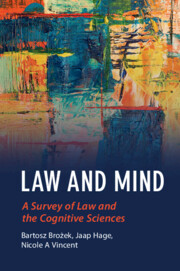Book contents
- Law and Mind
- Law and the Cognitive Sciences
- Law and Mind
- Copyright page
- Contents
- Figures
- Contributors
- Acknowledgements
- 1 Introduction
- I Metatheory and Methodology
- II Ontology and Epistemology
- III Legal Doctrine and Cognitive Sciences
- 11 Private Law and Cognitive Science
- 12 Private Law and Cognitive Science: A Methodological Commentary
- 13 Responsibility, Liability, and Retribution
- 14 Guilt in Criminal Law: Guilt in Us or in the Stars?
- 15 The Insanity Defense
- 16 Thoughts on the Insanity Defence
- IV Evidence
- V Dissenting Opinions
- References
15 - The Insanity Defense
from III - Legal Doctrine and Cognitive Sciences
Published online by Cambridge University Press: 21 April 2021
- Law and Mind
- Law and the Cognitive Sciences
- Law and Mind
- Copyright page
- Contents
- Figures
- Contributors
- Acknowledgements
- 1 Introduction
- I Metatheory and Methodology
- II Ontology and Epistemology
- III Legal Doctrine and Cognitive Sciences
- 11 Private Law and Cognitive Science
- 12 Private Law and Cognitive Science: A Methodological Commentary
- 13 Responsibility, Liability, and Retribution
- 14 Guilt in Criminal Law: Guilt in Us or in the Stars?
- 15 The Insanity Defense
- 16 Thoughts on the Insanity Defence
- IV Evidence
- V Dissenting Opinions
- References
Summary
Legal insanity is an element of many legal systems, and it has often stirred debate. It appears that many are intrigued by this defense, which touches upon a variety of enigmatic subjects, such as severe crimes, fairness, free will, retribution, and the reliability of expert testimony. In this chapter, key questions regarding the insanity defense will be considered. Why should insanity be part of our legal system? What should be the criteria for legal insanity? Can neuroscience help to assess a defendant’s sanity? Since legal insanity lies at the interface of law and psychiatry, we will have to consider both legal and psychiatric matters. As we are interested in the foundations of legal insanity, we will take moral philosophy into account as well.
First, we consider some arguments pro and con the insanity defense. This implies addressing certain challenges regarding psychiatric assessments, such as the fact that it concerns a past mental state, and the risk that defendants will malinger (faking bad) or hide their symptoms (faking good). Second, we will examine the components of several legal standards for insanity such as the M’Naghten Rule and the Model Penal Code test. Third, the idea that the defense relies on the possibility that a mental illness may compromise a person’s free will will be discussed. I will conclude that the notion of “free will” provides at best a partial justification for legal insanity. Many legal systems define a specific threshold of proof for insanity, for instance, “by a preponderance of the evidence.” We concisely consider the burden of proof, in particular the threshold of proof. Next, the ethics of forensic psychiatric assessment and testimony about a defendant’s insanity will be discussed. Since forensic psychiatric evaluations of defendants do not take place in a therapeutic doctor–patient relationship, the ethical context is also different from the standard healthcare setting. Finally, the role of neuroimaging in insanity evaluations will be considered.
- Type
- Chapter
- Information
- Law and MindA Survey of Law and the Cognitive Sciences, pp. 317 - 341Publisher: Cambridge University PressPrint publication year: 2021
References
- 1
- Cited by



